According to Statista, there are over five billion active Internet users worldwide, and 77% of them read blogs on a daily basis. That's a market worth entering to make a career.
Starting a blog can be a rewarding experience as you can share your ideas, thoughts, and passions with others. It can also be a source of income and a platform for building a community of like-minded individuals.
But how and where do you begin?
In this blog, I'll walk you through the necessary steps of how to start a blog.
So without further ado, let's start turning your blogging dream into reality.
Are you ready to create your blog and monetize it? Get started with the Dorik blog maker today.
11 Easy Steps of How to Start a Blog
In this guide, I will direct you through the following steps how to start a blog and turn that into a revenue stream.
-
Step 1: Determine Your Focus
-
Step 3: Choose a Blog Name
-
Step 4: Identify Your Target Audience
-
Step 6: Choose a Blogging Platform
-
Step 7: Set Up Your Blog Site
-
Step 8: Start the Writing Part
-
Step 9: Optimize the Blog for SEO
-
Step 10: Publish Your blog
-
Step 11: Promote Your Blog
Blogging is a marathon, not a sprint. So you have to bear with me till the end if you are serious about blogging as I explain all the steps.
Here we go.
1. Determine Your Focus
Determining the focus of your blog is a critical step when starting a blog.
Will you write review blogs?
How-to guides?
Case Studies?
Or little bit of everything?
You can take some time to decide your focus carefully. Once you do that, you'll be able to create relevant, engaging content that resonates with your audience.
Blog posts published by companies generated 67% more monthly leads.
Techjury
Good Reads:
2. Choose a Niche or Topic for Your Blog
Choosing a niche is another crucial step when starting a blog. A niche is like the tip of the iceberg. It is a specific topic or area of focus that your blog will cover. You'll be able to attract a particular audience and establish yourself as an expert in that area when you choose a specific niche.
Take digital marketing, for example. It is a vast sector with widespread branches, so it will be hard to cover everything related to digital marketing. So, you will have to dive deeper and pick a specific category like SEO, Content Marketing, or Social Media Marketing. One of them can be your blogging niche.
Fashion blogging can be another example. You can start a fashion blog for teens, college students, or corporate people. You can also go deeper and pick a niche topic related to fashion.
👉 Feeling confused about choosing a niche? Check out our blog on 127 Profitable Blog Niche Ideas to kickstart your journey.
There are several reasons why choosing a niche is important for starting a blog:
-
When you have a specific niche, you'll have a clear idea of the topics you should cover.
-
You'll be able to attract a specific audience interested in that topic.
-
It will let you demonstrate your expertise and build credibility with your readers.
-
When you have a clear idea about your niche, you can create consistent content that aligns with your goals and audience.
If you want to stand out, pick some niche with low competition. Then, do some research to find your perfect niche. Google Trends can be your starting point for that. You must choose a profitable blog niche for better output.
Related Read: How to Start Money Blogging
3. Choose a Blog Name
A name gives an identity to your blog that people will remember and search in Google to find you. So, take some time to brainstorm and write down the names or words that come to mind. This process might be tedious for some of you, but it is crucial for your blogging journey.
You can consider the following factors to come out with the perfect name if you are confused about how to choose a blog name:
-
The name could be relevant to the topic or theme of your blog.
-
Choose a name that is easy to remember and spell. That will make it easier for people to find and share your blog. Avoid homophones (words that sound similar but have different meanings) and hyphens (they can create confusion).
-
Try to come up with a unique name that is not already used by another blog or website.
-
A short and simple name is easier to remember and type. It also looks better on social media profiles and other places where your blog name might be displayed.
-
After deciding on a name, check if the domain name (e.g., YourBlogName.com) is available. You can use Namecheap to check the availability. If the name is unavailable, you may need to add an extra word with the name, use a synonym, or come up with a different name to make it unique.
Besides knowing how to create a blog, it is crucial to understand how to choose a perfect name for your blog.
4. Identify Your Target Audience
Your target audience is the people who will read your blogs. Therefore, a clear understanding of your target audience will determine your blog's success.
You can ask yourself some questions and then find their answer to understand who will be your target audience. Ask these questions:
Who will be interested in reading a blog on that topic?
What problems are your blog solving?
Does your blog resonate with any community?
If you can find the answers to these questions, you can easily decide your target audience. Creating buyer personas, or in this case, "Audience personas," is another excellent way to understand your audience. You can create an audience persona to generate customized content for a specific audience.
An audience persona will cover topics like your audience's interests and pain points so you can plan your content based on them. When you write a blog on something your audience is interested in, they're more likely to read it thoroughly.
That's how a general reader will become your regular audience, which measures your blog's success.
5. Consider Your Long-term Goals for Your Blog
If you are starting a blog as a hobby, then you don't need any long-term plans, but if you want to make a career or income stream out of it, you must have a curated long-term goal. And once you have proper information on how to create a blog, you must begin to create a long-term plan for it.
Starting a blog can be an exciting and rewarding experience, but it's essential to have long-term goals in mind to help guide your efforts and keep you motivated.
For example, suppose your long-term goal is to become a successful blogger and make a full-time income from your blog. In that case, you might focus on creating high-quality content that resonates with your audience and building a loyal following.
You might also work on monetizing your blog through advertising, sponsorships, or selling products or services.
On the other hand, if your long-term goal is to share your thoughts and experiences with a small group of people, you might focus on creating a personal site with blogs that reflect your personality and interests.
6. Choose a Blogging Platform
You will need a platform to publish and manage your blogs if you want to do it efficiently. So, let's discuss how to choose a blogging platform, shall we?
When choosing a blogging platform, there are several factors you should consider:
-
Look for a user-friendly and easy-to-navigate platform, especially if you are new to blogging.
-
Choose a platform that allows you to customize the design and layout of your blog to match your brand and style.
-
The platform must offer a wide range of features and tools, such as managing posts efficiently, adding images and videos, and integrating with social media.
-
Choose a platform with good SEO capabilities to help your blog rank higher in search engine results.
-
Consider the cost of the platform. It includes any monthly or annual fees, as well as any additional charges for features or tools.
-
Look for a platform that offers good customer support, including documentation and resources to help you get started and troubleshoot any issues.
You can explore the Dorik CMS platform as your potential blogging platform because you can easily create and optimize blog posts using Dorik CMS.
In addition, it is a no-code website builder, so you don't need any development or design knowledge to build a blogging website using Dorik.
You will love the user-friendly interface and the convenient functionalities. It is budget-friendly too.
👉 You can also check out our list of the best website builders for blogs to compare your options.
7. Set Up Your Blog Site
Setting up a blog site is now easier than ever. Dorik lets you set up a fully designed and functional website in 6 simple steps.
Step #1: Create an Account
Visit Dorik and click “Try Free Now.”

It will take you to a Signup / Login page. You can use a Gmail account and set a password to get started, or you can sign in with a Google account. No additional information is required in this step.
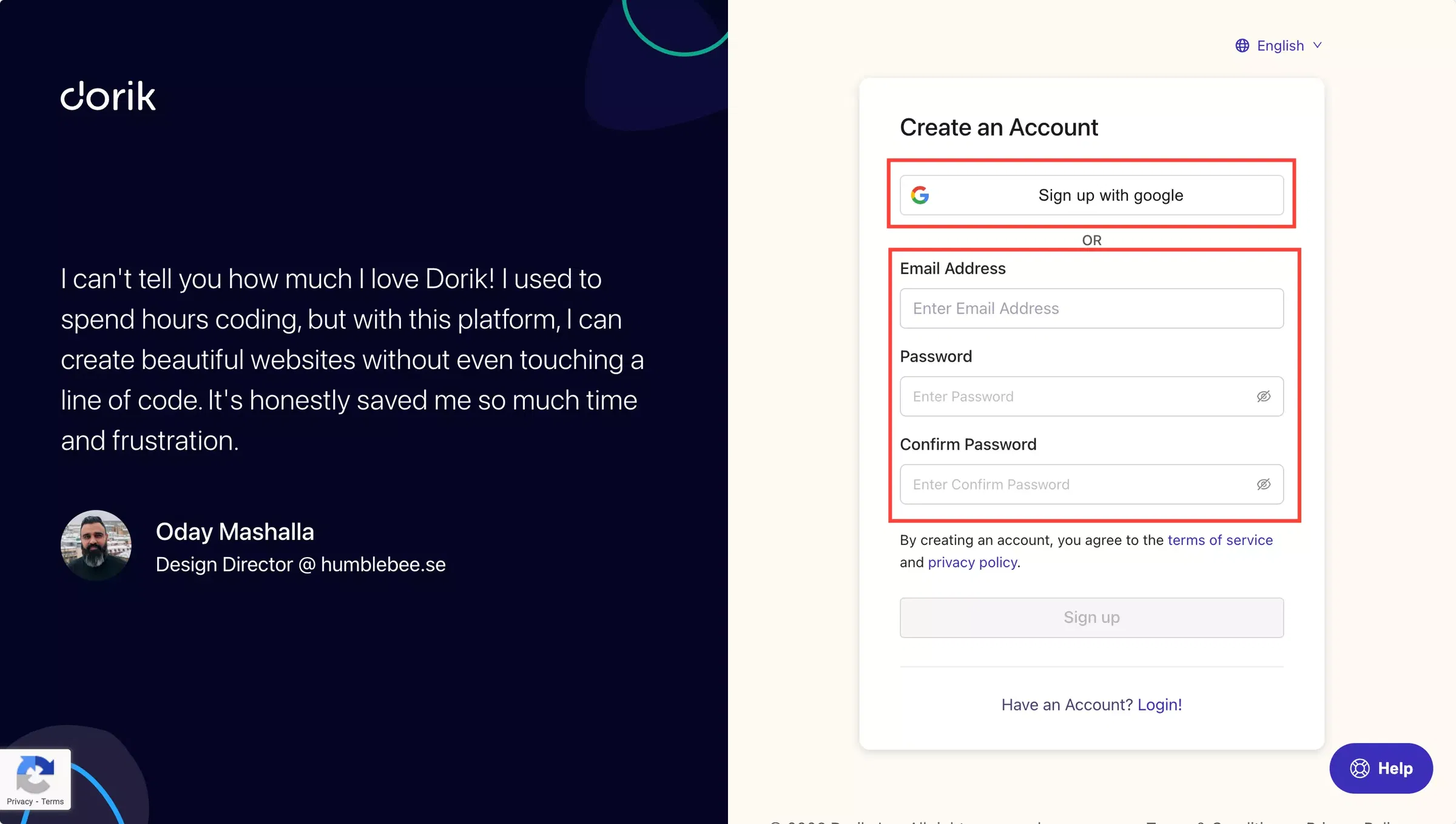
Step 2: Enter the Dashboard
Once the signup is complete, you will enter the Dorik dashboard. This will be the hub for all the websites you create with Dorik. Click on "Create New CMS Site" to start creating your blog.
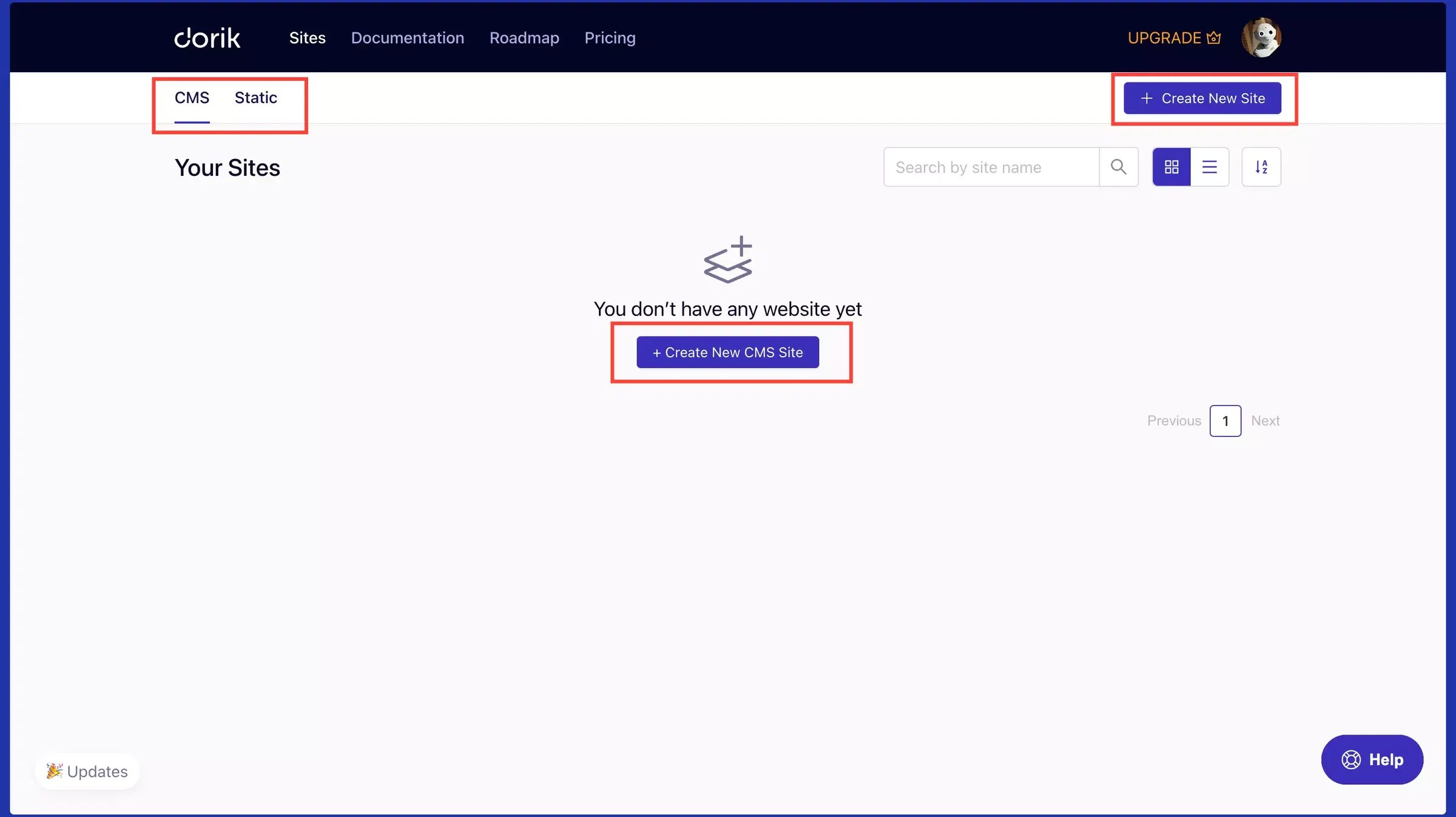
You will see the starting point where you can select a template for your blog site. You can use a dedicated blog website template or choose from other catchy and unique templates.
I am selecting “TecNuse Blog Template,” for example. Click “➕” icon to use this template and access the Dorik CMS dashboard.

Click “👁️” icon to see how your website will look using this template.

Step 3:Create Your Project and Acess Dorik CMS Dashboard
You will have to give a name to your project and set a subdomain name before accessing the dashboard. The subdomain is free to use under Dorik's primary domain.
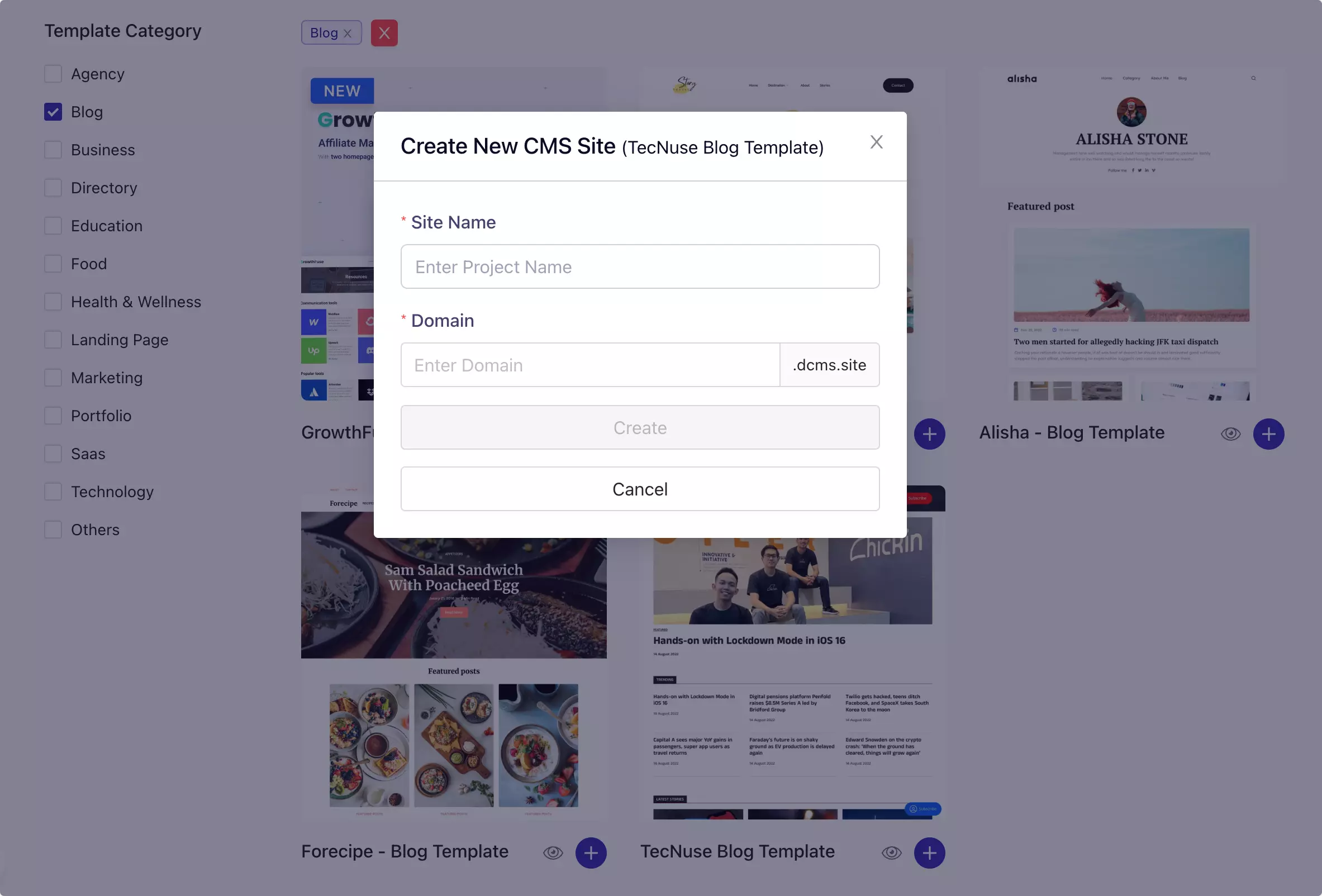
You can connect a custom domain in the future from the CMS dashboard with a premium plan.
The CMS dashboard will be the central hub for controlling your website and its content. You can read the step-by-step guides to Dorik CMS to get yourself familiar with all the functionalities of the Dorik CMS dashboard.

Step 4: Explore the CMS Dashboard
When you click on the “Posts” option from the CMS dashboard, you’ll see all the posts as a list. In addition, you’ll see a button to create a “New Post,” which will take you to the post editor of Dorik CMS when clicked. You can also click on the three dots available on the right corner of each post to see a list of things you can customize.
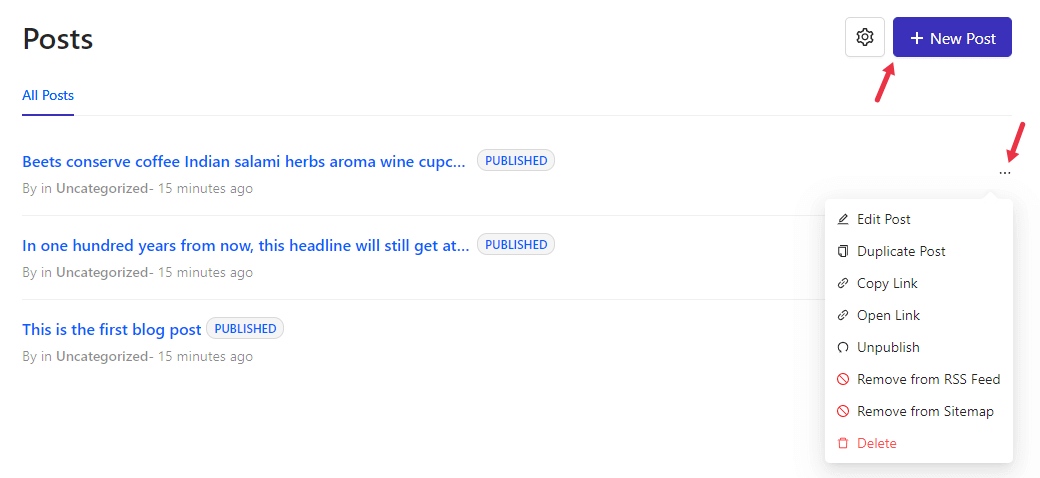
The post editor will be the place where you will spend most of your time when you create a blog website because that’s where the magic will happen. The editor will be your workshop, where you will craft your words into captivating content.

You will get a list of what you can add to the main body of the blog when you click on the “+” button available at the left-side border of the post editor.
You will get a ton of settings to customize for your blog post by clicking on the settings icon at the top right corner of the post editor.

Step 5: Enter into the Website Builder
The "Design & Pages" option will take you to the website builder page, where you can edit and customize your chosen template. Every element of the templates is customizable, so you have flexibility in terms of your website design.
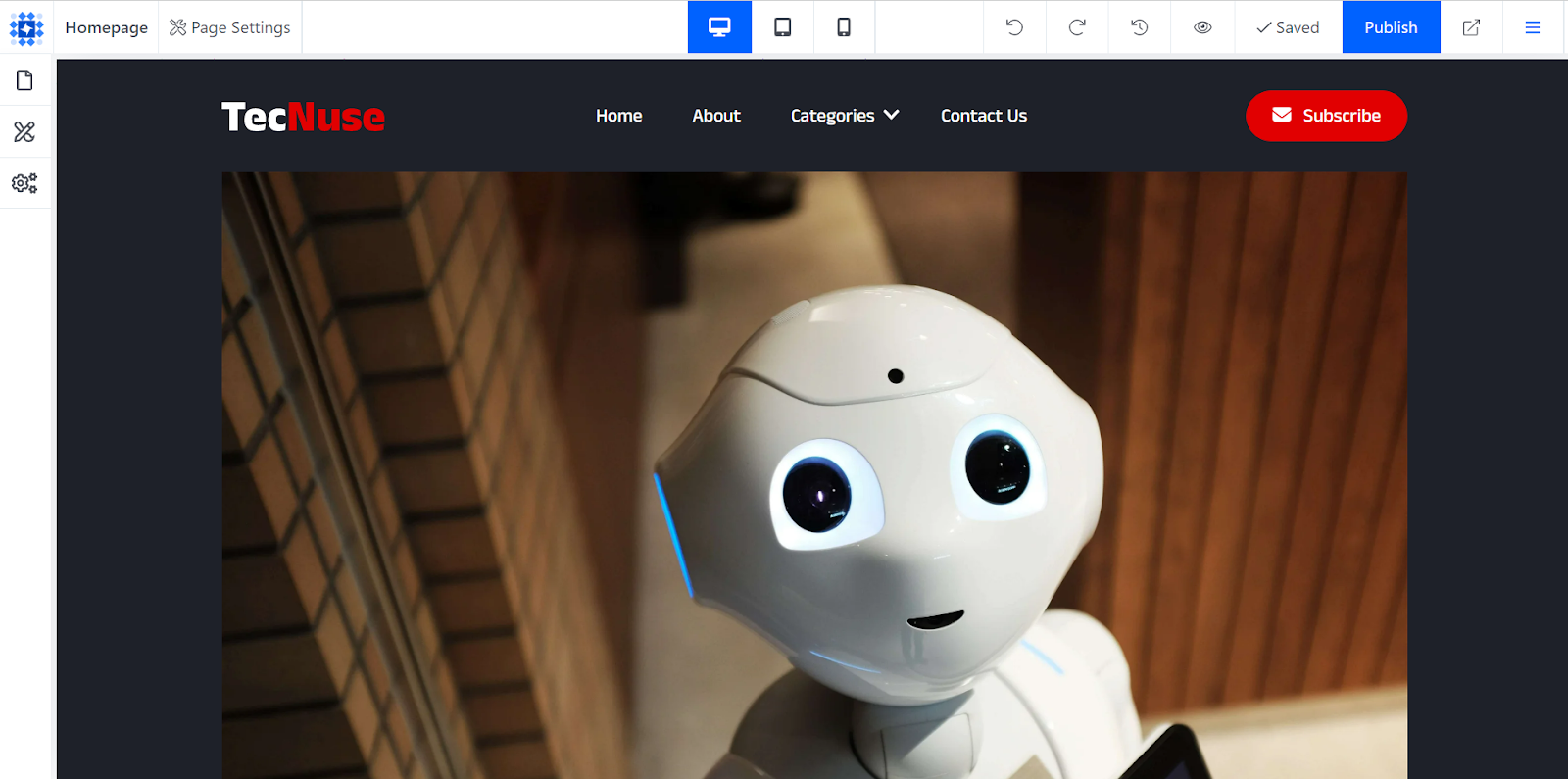
Dorik offers plenty of tutorials explaining how to use the website builder to design awesome websites just by dragging and dropping, with no coding or designing skills.
For example, let's say you want to change an image of the template. Just click on the image, and a pop-up box will appear with all the settings you can play with for a photo. You can remove the current image, upload a new one, use styling, and much more.
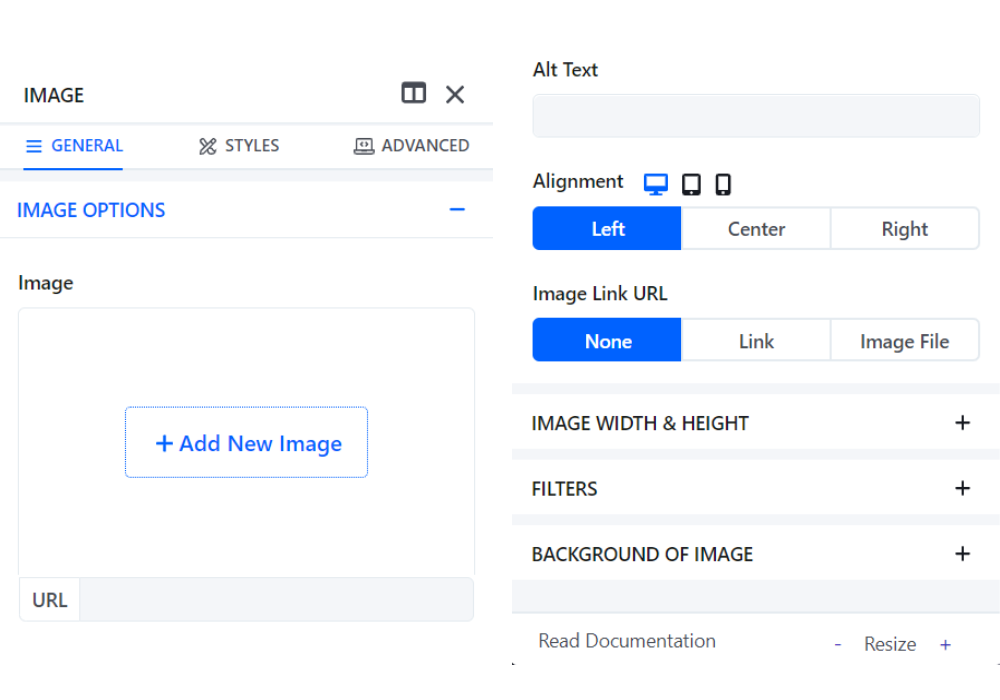
You can click the "👁️" icon to "Preview the site" during editing to see how a change will look if you publish it. Then, when you are happy with the design, you can click Publish, and all your changes will be instantly published.
You can click the upward arrow icon (available at the top right corner) to see the live version of your site.
Step 6: Change the Template Design
You can watch a video on How to design a blog post template and learn how to create a catchy template for your blog posts.
You can also create a custom collection for convenient blog posting. It is impossible to mention all the functionalities here. So I'm trusting you with the responsibility of exploring other available functionalities. I assure you that you will love what you find during your exploration.
Read: How to use Dorik custom collections
After grasping the blog posting process and managing the content, you have to set up some essential pages on your site, like the Contact and About pages.
Helpful content: About us page example , How to create contact us page

The TecNuse blog template comes with those pages, and they are fully designed. It will save a lot of valuable time on your part as all you have to do is replace the pieces of information. You can give it a try.

8. Start the Writing Part
Best Practices for Writing
If you want to become a good writer, you can follow some best practices for writing. You have to read a lot, too. Reading blogs written by topic experts will enhance your writing skills as you will learn new vocabulary and understand what type of writing attracts readers more.
To ensure that your blog is well-written, informative, and engaging, here are some tips to help you become a better writer:
-
Writing a blog post you're genuinely interested in will make the process more enjoyable and help you produce high-quality content.
-
Before you start writing, you must thoroughly research your topic to ensure that your information is accurate and up-to-date. This can help you to provide valuable insights and perspectives to your readers.
-
Using language that is easy for your audience to understand is vital. Avoid jargon or overly complex language, and aim to keep your sentences short and to the point.
-
Headings and subheadings help to break up your content and make it easier for readers to scan and navigate your blog post. Use descriptive titles that convey the main points of each section.
-
Visual elements like images, videos, and infographics can break up your content and make it more engaging for readers. Just be sure to use high-quality, relevant photos and credit any sources you use.
-
Always make sure to proofread your blog post for spelling and grammar errors before publishing. Have someone else read over your content to catch any mistakes you may have missed.
👉 If you ever feel stuck when writing a blog, read our blog on how to overcome writer's block and get going.
Select a Writing Style and Stick to It
A unique writing style will set you apart from the crowd. If you can establish your own writing style, your regular readers will instantly understand they are reading your blog and pay more attention to it. You must improve your writing style to create your unique identity as a writer.
Maintaining a consistent writing style is essential for several reasons when blogging.
-
A consistent writing style helps to establish the tone and voice of your blog. It allows your readers to get a sense of who you are and what your blog is about, and it can help to set your blog apart from others in the same niche.
Some examples of writing styles are informative, humorous, inspirational, friendly, etc. You can check out different writing styles for more inspiration.
It helps to improve the readability and clarity of your blog. Switching back and forth between different writing styles can confuse your readers and make it harder for them to follow along.
Sticking to a consistent writing style can make your blog more accessible and enjoyable for your readers.
A consistent writing style can help to build trust with your readers. When readers know what to expect from your blog, they are more likely to return and read more of your content. This can build a loyal readership and make your blog more successful.
👉Related Read: How to Start a Food Blog.
9. Optimize the Blog for SEO
You need more than just knowing how to start a blog to make it successful; you also have to optimize your blogs for SEO properly. Optimizing your blog for search engines, also known as search engine optimization (SEO), is vital for several reasons:
-
Optimizing your blog for relevant keywords can increase your visibility in search engine results pages (SERPs).
-
It can also improve the user experience. Search engines try to provide users with the most relevant and valuable content. So, if your blog is well-optimized, it will be easier for users to find and read your content, leading to longer engagement times and a higher likelihood of returning visitors.
-
When your blog appears at the top of search results, it can increase your credibility as a thought leader in your industry. This is because search engines often rank websites that are well-written, informative, and authoritative higher in their results.
-
SEO can also help to increase brand awareness.
👉 If you have any questions on your mind about SEO, chances are we already covered it in our blog 60+ Top SEO FAQs.
10. Publish Your Blog
When we write a blog, our ultimate goal is to share that blog with the world, right? That's what you have to do in this step.
Here are some key points to consider when publishing a blog.
Selecting a Domain Name
Choose a domain name that is easy to remember. Your domain name is the address of your blog, so it should be relevant to your blog's content. It's essential to choose a domain name that reflects your brand and is easy for your audience to remember.
Your domain name can be your blog's name. If that isn't available, try to find close synonyms or add an extra word before or after the name.
You can check the availability of a domain name and buy one from domain name registrars like Namecheap and GoDaddy.
The domain name will be your blog's online identity, and people will search for your blog using that name. So, be extra careful when choosing a domain name.
You can easily add your custom domains with each premium CMS Plan of Dorik.
Ensure Enough Storage
Storage or hosting is the servers and infrastructure needed to host your blog on the internet. But you won't have to worry about the storage if you subscribe to any premium plan of Dorik, as all the plans include unlimited storage space.
You can publish as much content as you want without ever running out of storage space. You can save yourself from the hassle of managing a separate hosting plan if you use Dorik CMS.
Establish a Content Strategy
A content strategy is a plan for creating and publishing content on your blog. It should include a schedule for posting new content, as well as guidelines for the types of content you will publish.
Doing this will give your regular readers clarity on when to visit your site for new content. You will also get more subscribers if the visitors like your upcoming content plan.
11. Promote Your Blog
You can increase the visibility of your blog site, and your blog can reach a wider audience through proper promotions. A blog can be a powerful tool for sharing information, ideas, and stories with others, but it is only effective if people can find and read it.
Promoting your blog can ensure that more people are aware of your content and can engage with it.
There are many ways to promote a blog; the best approach will depend on your goals and resources. Some tips I can share for promoting a blog are:
-
Share your blog posts on social media platforms such as Twitter, Facebook, and LinkedIn to reach a wider audience. According to Optinmonster, more than 95% of bloggers use social media to promote their blogs.
-
Join forums and discussion groups related to your blog's topic and share your content there. This helps establish your credibility and build a loyal audience.
-
Partner with other bloggers in your niche (if possible) to cross-promote each other's content. This can be a great way to tap into their audience and build relationships with fellow content creators.
-
You can write content to publish on other bloggers' sites as a guest and try to divert the readers to your site.
-
If you have a mailing list, use it to promote your blog to your subscribers. You can also consider using email newsletters to share your latest blog posts and other updates with your audience.
How to Monetize a Blog
A successful blogger should have knowledge about monetizing their blogs. If you invest your valuable time in blogging and can't earn from it, that will be considered a failed investment.
Monetizing your blog can be an excellent way to support your passion, generate income, and reach a wider audience. However, it is vital to approach monetization in a way that is ethical and aligns with your values and goals as a blogger.
I will share some legit ways that you can pursue to earn money from your blog. All of them are long-term income streams, so there'll be stability in your revenue.
Google AdSense
Displaying ads provided by Google on the blog site is a popular way of making money from blogs. Google AdSense is a program that allows you to place targeted advertisements on your blog and earn money from clicks or impressions.
To connect your blog site to Google AdSense, you need to sign up for the AdSense program to create your account. It will take some time to get your AdSense account approved.
Once approved, you can connect your account to your blog site and earn by showing customized ads.
It is important to remember that the amount of money you can earn from AdSense will depend on various factors, including the traffic to your blog, the relevance of the ads to your content, and the quality of your content.
Affiliate Programs
Affiliate programs are another popular way for bloggers to earn money from their content.
The first step in earning money from affiliate programs is finding programs relevant to your blog's topic and audience.
There are many affiliate programs available. You can find them through affiliate networks, such as Commission Junction or ShareASale, or directly through research about companies related to your niche.
Or you can join the Amazon affiliate program and promote your niche-relevant products and earn a commission when someone purchases through your link.
👉 You can also check out our money-making list of the highest paying, best recurring affiliate programs in various niches.
Once you have found the affiliate programs you are interested in, you will need to sign up to become an affiliate. This typically involves filling out an application and providing basic information about yourself and your blog.
After you have been accepted as an affiliate partner, you can start promoting the products or services to your audience. You can write blog posts that review or feature the products or include links to the products in your blog posts or on your website.
Try to find affiliate programs that are highly profitable for you. Take Dorik Affiliate Program, for example.
You can earn up to 40% recurring commission from Dorik as an affiliate. That means for every $100 purchase from someone who clicked your link to visit; your cut will be $40, which is huge.
It is essential to be transparent with your audience about your use of affiliate links. Only promote products or services you believe in or use for yourself and would recommend to your readers.
Product Selling
Once you grow an extensive fan base by writing content on a specific niche, you become a brand. That's when you can think about selling the niche-related products you feel will benefit your audience.
For example, if your blog niche is "winter camping tips," you can consider selling suitable camping gear everyone should take with them during winter. It is relevant to your niche and fits the bill perfectly.
Furthermore, if you are an author, you can consider selling your eBooks from your blog site. Another option is to offer eBooks as a free opt-in incentive for subscribing to your email list. This can help you grow your email list and generate more leads for your business.
Offer Premium or Gated Content with a Subscription
You can create exclusive premium or gated content for your subscribed members, share unique and premium resources, and offer other perks so that they feel it is worth subscribing to your site.
Subscription-based monetization can be a great way to generate recurring revenue from your blog. Just make sure to offer valuable content and resources to your subscribers to ensure they continue to renew their subscriptions.
You can create a membership program on a monthly or yearly basis. If your niche selection is perfect and your content quality is genuinely good, you will surely get some subscribers.
With Dorik CMS, you can easily add a membership feature to your blog site.
Guest Blogging
Earning through guest blogging is a bit complicated as there are multiple angles to it. The simplest angle where you can make money is to accept guest posts and charge the author to publish them on your blog site.
You will earn some money and the author might earn some backlinks, so it’ll be a win-win situation for both of you.
But before allowing guest posting on your blog site, you have to set some rules and regulations about what types of posts you will accept. Never post low-quality or irrelevant content to your blog site niche. That will hamper your credibility with your audience.
How to Start a Blog for Free and Make Money?
You can start a blog for free and make money with a blogging platform like Dorik CMS. You can create your site, create posts and publish them without spending a penny. But, if you plan to earn from your blog site you’ll have to spend a small amount to kickstart the journey.
That investment will get you a domain name to build your own brand, and a hosting space to store all your content. Besides that, spending that little money will open many doors of opportunity for you to earn money from blogging.
You can start affiliate marketing, enable google Adsense or generating leads for business.
Can Anyone Write a Blog?
Yes, anyone can write a blog. Blogging is a form of self-expression and allows individuals to share their thoughts, ideas, and experiences with a broader audience. There are no specific requirements or qualifications to start a blog other than having basic writing skills and enough patience.
Most blogs are written in an informal tone, so you won't have to learn formal writing. You have to do enough research on your favorite topic to make yourself knowledgeable enough to have something to share.
How Much Time Does It Take to Run a Blog?
The amount of time it takes to run a blog will depend on your goals and the volume of content you plan to publish. If you want to publish new content regularly, you may need to spend significant time researching, writing, and promoting your posts. If you only plan to publish occasional updates, you can manage your blog with less time investment.
How to Start a Blog with Your YouTube Content?
To repurpose YouTube content for a blog post, follow these steps:
Choose a YouTube video: Select a video from your YouTube channel that has valuable content and would work well as a written blog post.
Transcribe the video: Transcribe the audio from the video. You can either do it manually or use transcription services or software available online.
Edit and structure the transcription: Edit the transcription to ensure it reads well as a written post. Break it into paragraphs, add headings, and remove any unnecessary repetition or filler words.
Add an introduction: Write a brief introduction to provide context and engage readers. You can summarize the main points of the video or share a personal anecdote related to the topic.
Incorporate visuals: If your video includes visuals or slides, consider adding relevant images or screenshots to your blog post. This enhances the reading experience and helps illustrate your points.
Format for readability: Make your blog post easy to read by using bullet points, subheadings, and numbered lists where appropriate. This improves readability and allows readers to skim through the content.
Enhance with additional information: Expand on the content of your video by providing additional insights, examples, or resources in the blog post. This adds value and makes the post more comprehensive.
Optimize for SEO: Identify keywords related to your blog post topic and incorporate them naturally throughout the content. Use descriptive headings, meta tags, and relevant URLs to improve search engine visibility.
Include a call to action: Encourage readers to engage further by leaving comments, subscribing to your blog or YouTube channel, or sharing the post on social media. A clear call to action can help grow your audience and foster interaction.
Proofread and publish: Proofread your blog post for grammar, spelling, and formatting errors. Once you're satisfied with the quality, publish it on your blog and promote it through your various channels.
Start Blogging to Express Yourself
The key to a blogger's success is having a passion for your topic and a desire to share your thoughts and ideas with others.
Anyone can start a successful blog with the right attitude, dedication, and effort. And, Dorik made it easier for everyone to set up a blog site easily and kick-start their journey as a blogger.
Whether you want to monetize your blog or just want to share your thoughts and expertise, many options are available to help you get started.
Now you have the proper knowledge on how to create a successful blog and make money from it, so don't waste any more of your valuable time to get started.





